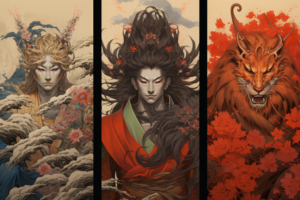Izanami holds a significant place in Japanese mythology as a goddess associated with creation, death, and the underworld. Alongside her brother and counterpart, Izanagi, she played a crucial role in the formation of Japan and the birth of numerous deities. Together, they embarked on a divine journey that shaped the very fabric of the world.
Appearance
Izanami is often depicted as a graceful and ethereal goddess. She is portrayed as a beautiful woman adorned in elegant robes, symbolizing her divine nature. Her countenance exudes a sense of wisdom and serenity, while her presence carries a profound aura of both creation and destruction. Izanami’s appearance reflects her dual roles as a giver of life and a guide in the realm of death.
Powers & Abilities
As a goddess associated with creation and death, Izanami possesses extraordinary powers and abilities. She has the ability to give birth to new life, shaping the landscapes and creatures of the world. Simultaneously, she holds authority over the realm of the dead, guiding departed souls through the afterlife. Izanami’s powers encompass both the forces of creation and the mysteries of the underworld.
Family
Izanami’s family connections are deeply intertwined with the creation myth of Japan. She is recognized as the wife and counterpart of Izanagi, with whom she embarked on the divine act of procreation. Their union resulted in the birth of numerous deities, including major figures such as Amaterasu, the goddess of the sun, and Susanoo, the god of storms and the sea. Izanami’s familial ties connect her to the entire pantheon of Japanese gods and goddesses.
Izanami and Izanagi
Upon witnessing Izanami’s tragic demise while giving birth to the fire god Kagutsuchi, Izanagi was consumed by anger. Gripping his sword Ame-no-Ohabari, he mercilessly cut the fire god into fragments. As Izanami was laid to rest in Mount Hiba and she herself resided in the underworld realm of Yomi, Izanagi resolved to venture there and reclaim his beloved wife. Although she promised to plead with the rulers of Yomi for her release, Izanagi’s impatience got the better of him, and he disregarded her wishes by igniting a torch. To his horror, he beheld his once beautiful wife reduced to decaying bones, infested with maggots. Overwhelmed by revulsion, Izanagi hastily fled. In retaliation, Izanami dispatched a horde of grotesque female spirits, warriors, and eight thunder gods to pursue him. Yet, by evading the clutches of the underworld, Izanagi succeeded in sealing the entrance with a massive boulder.
From behind the obstructing rock, Izanami cried out, threatening to claim the lives of a thousand people each day if he abandoned her. Undeterred, Izanagi defiantly declared that he would bring forth fifteen hundred lives each day. This marked the dissolution of their marriage, with Izanagi assuming the role of the god governing the realm of the living, while Izanami became the queen of the land of the dead.
Symbol
Izanami is associated with several symbols that represent her domains and attributes. The Yomotsu Hirasaka, the entrance to the underworld, is a significant symbol associated with her role as a guide in the realm of the dead. Additionally, the magatama, a comma-shaped jewel often associated with fertility and protection, is a symbol closely linked to Izanami. Other symbols may include representations of the land and the cycle of life and death.
Worship
Izanami is venerated in Shintoism, the indigenous religion of Japan. She is often revered through prayers and rituals performed at specific shrines dedicated to her honor. Rituals may involve offerings of food, flowers, and other symbolic items. Worshipers seek Izanami’s blessings for fertility, protection, and guidance in matters of life and death. Ceremonies dedicated to Izanami often involve purification rituals and invocations to ensure the smooth passage of departed souls.
Facts about Izanami
- Izanami’s descent to the underworld following her death during childbirth is a pivotal event in Japanese mythology, illustrating the cyclical nature of life and the duality of creation and death.
- Legends depict Izanami as a compassionate and benevolent goddess, who cares for the souls of the departed and ensures their safe journey through the afterlife.
- Izanami’s association with death and the underworld influenced traditional Japanese funeral rites and mourning practices, emphasizing respect for the deceased and the continuation of ancestral connections.
- In some versions of the mythology, Izanami’s children, born from her union with Izanagi, were initially deformed or monstrous. This event further emphasizes the delicate balance between creation and destruction within the natural order.
- Izanami’s presence extends beyond the realm of mythology and into popular culture. She is often referenced in Japanese literature, music, and art as a symbol of feminine power, strength, and the mysteries of life and death.
- Izanami’s role as a maternal figure and her association with childbirth have made her a deity to whom women pray for safe pregnancies, healthy deliveries, and the well-being of their children.Izanami’s role as a creator and giver of life is mirrored by her association with death and decay. She represents the cyclical nature of existence, where life emerges from death, and death leads to rebirth.






